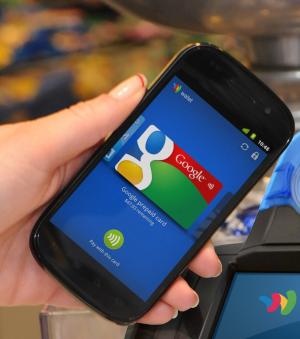Google’s Motorola Acquisition Likely to Boost Google Wallet Rollout

Google’s acquisition of Motorola's mobile phone business would boost the roll out of phones supporting NFC and the Google Wallet, though not by a huge amount and not in the short run, say observers.
Google, which today announced plans to acquire Motorola Mobility for $12.5 billion in cash, would become a handset maker in its own right. That and Motorola’s portfolio of 17,000 patents would help Google stay competitive with Apple and the new Microsoft-Nokia partnership in the fast-moving smartphone market, say analysts.
Motorola, while seeing its market share drop in recent years to Apple, Samsung Electronics, HTC and others, is still a major supplier of smartphones supporting Google’s Android operating system.
But it is the only major Android phone maker to date that has yet to come out definitively in support of NFC. That is likely to change if Google gets expected regulatory approval to make the acquisition. A strong backer of NFC, Google is expected to incorporate NFC in the Android phones made by Motorola, which would operate as a separate unit within Google.
Google plans to launch its Google Wallet in the United States in early September and is expected to have only one model supporting it at the debut–its own Nexus S 4G. Google did not respond to a question from NFC Times on whether plans call for all new Motorola Android phones produced under Google to support NFC.
According to U.S.-based market research firm Nielsen, Motorola owned 11% of the U.S. smartphone market in June, thanks to its Android phone shipments. It ranked as the second largest Android phone maker stateside after HTC, which had a 14% market share of phones supporting Android, the most popular smartphone operating system in the country.
Worldwide, Motorola shipped just under 38.6 million consumer mobile phones of all types in 2010, ranking it seventh worldwide, according to U.S.-based research firm Gartner. But Motorola's worldwide phone market share was 2.4%, only half of what it was in 2009, said the research firm.
U.S.-based Pyramid Research has projected that just 17.5 million NFC-enabled smartphones will be sold this year and fewer than 100 million next year, and that will not change with Google’s purchase of Motorola, predicts Stela Bokun, senior analyst. Those are conservative estimates compared with many other analysts.
“It's possible that Google will now be able to speed up the growth of the NFC ecosystem down the road, beyond 2012, as it has now penetrated another segment of the value chain,” she told NFC Times. “However, we shouldn’t forget who the main obstacles to the growth of the NFC ecosystem are: consumers, retailers, mobile operators. These guys will still face the same challenges they have been facing yesterday, before Google's acquisition of Motorola.”
She agreed that the acquisition would have added benefits for Google on the NFC front, giving it the ability to control secure elements in more handsets.
The Web giant wants that control for its Google Wallet, since both payment applications and offers in the wallet are stored on the secure chip. Control of the secure element would enable Google to control revenue from NFC, though it has promised not to charge payment issuers to put their applications in the wallet.
Google controls the embedded chip in the Nexus S, made for it by Samsung. To gain some control over secure element in other handsets, Google would have to do deals with handset makers or mobile operators. That would be in addition to its Motorola-made phones. For those, it still would likely face resistance from mobile operators that sell the phones, if those telcos were offering their own NFC wallets.
“While Google’s OEM (original equipment manufacturer) Android partners have bought into producing NFC-enabled handsets, they controlled the secure element, said Bokun in a post. I don’t think Google was particularly enthusiastic about that.”
Of course, the risk of Google getting directly into the hardware business with Android phones is that it might alienate other Android phone makers, said Yankee Group senior analyst Nick Holland. And if they bolt, they would take their NFC chips with them.
Google's acquisition potentially means a significant increase in Google Wallet-enabled phones “since they now effectively own 10% of smartphones in the U.S.,” he said.
“But Samsung, HTC, etc., may break ties considering that Google will now be directly competing with them for device market share,” he told NFC Times. “This may drive other manufacturers to alternative operating systems, such as Microsoft.”
Google’s CEO Larry Page said in a blog post today that Motorola would remain only a licensee of Android. “This acquisition will not change our commitment to run Android as an open platform,” he said.
Google entering the NFC market directly as a phone maker will also give it more control over how NFC gets implemented in its phones, not having to rely on other handset makers, such as Samsung, said NFC expert Einar Rosenberg, CEO of Narian Technologies.
“Now Google doesn’t have to use third parties to build their super phone, they can build it just like Apple and compete more directly with Apple, while still offering their OS to third-party manufacturers,” he said.
Motorola has not been entirely absent from the NFC market, despite the handset maker's reluctance so far to commit to rollouts. Its SLVR L7 was used in trials in the United States, France and Germany the past few years, including a pilot of SIM-based transit ticketing by German national rail operator Deutsche Bahn and three major mobile operators.
And there is a commercially available NFC phone model that carries the Motorola mark, though not from Motorola Mobility. Motorola Solutions, the new name for U.S.-based Motorola Inc., the electronics giant from which Motorola Mobility spun off in January, introduced an NFC-enabled mobile computer in April. The phone, the MC75A HF RFID Contactless, is targeted at enterprises.












